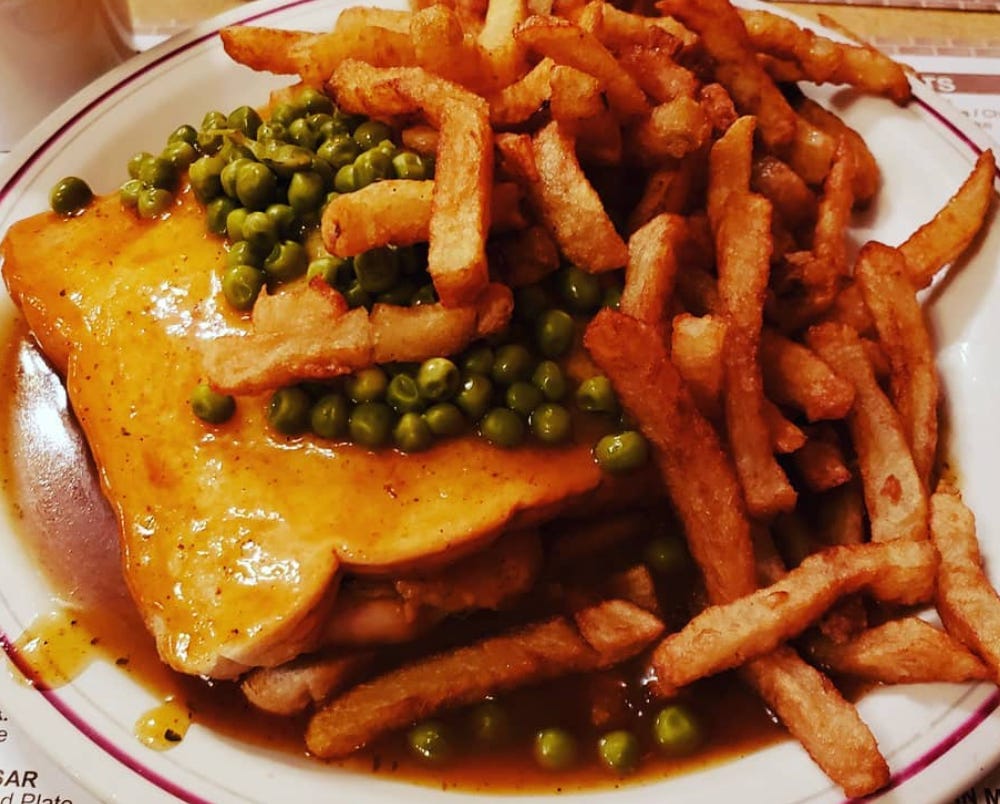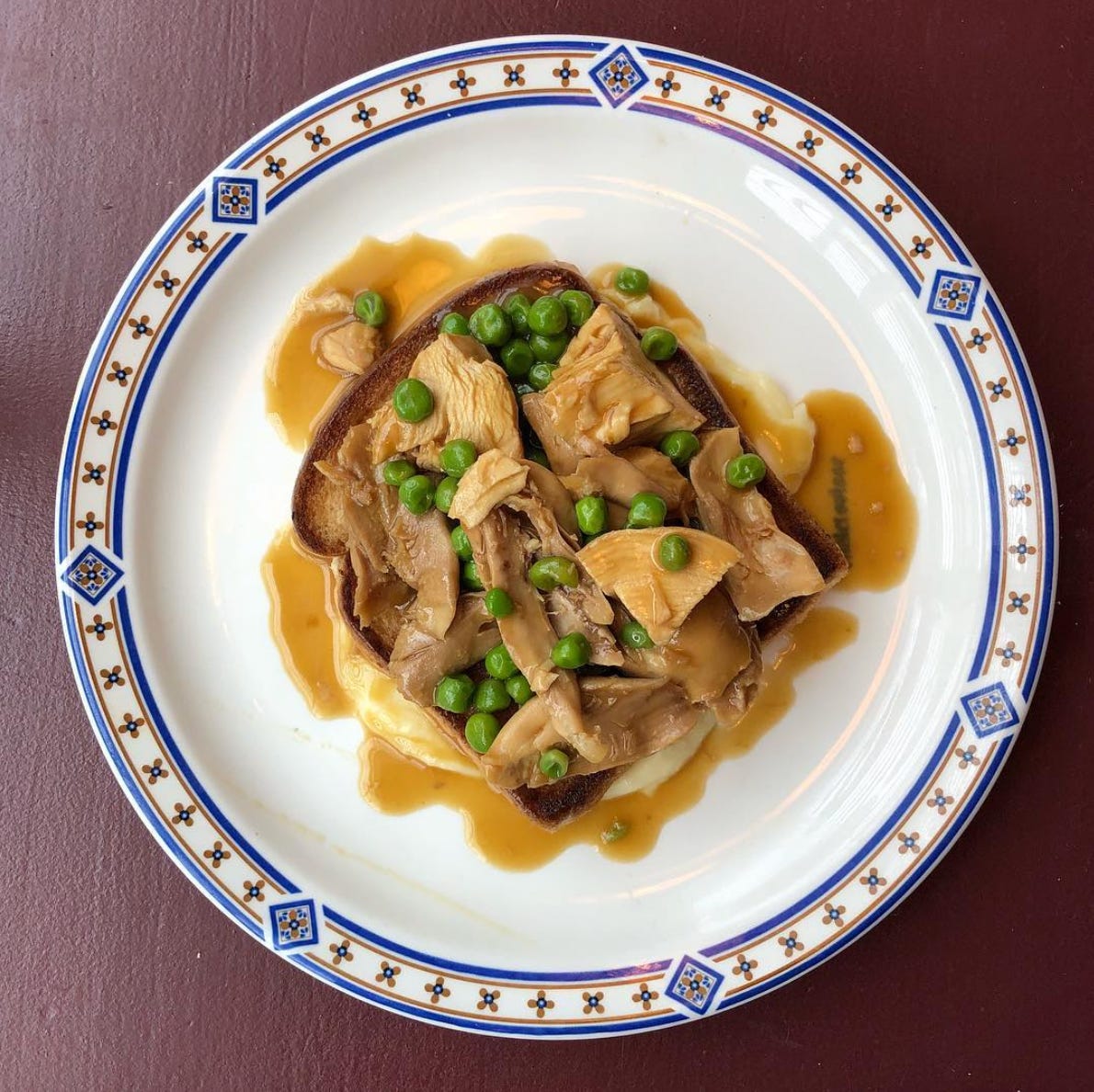Notable Sandwiches #26: Canadian Hot Chicken
A comfort food from the Great White North, and a lesson in the mutability of Wikipedia
Welcome to the latest installment of Notable Sandwiches, the feature where I, alongside my editor David Swanson, stumble through the demented and mysterious document that is Wikipedia’s List of Notable Sandwiches. This week: a Quebecois classic, the Canadian Hot Chicken Sandwich.

This week, when I checked the Wikipedia List of Sandwiches, I found myself astounded: had I somehow skipped a sandwich before writing last week’s history of the carrozza? There, in the accusatory and undeniable type of a spreadsheet row, was a brand-new entry: the “Canadian Hot Chicken Sandwich,” a profoundly unappetizing-looking bit of sandwichery I could swear I’d never seen before. Was I going nuts? Making unjustifiable errors?
Or was I falling victim to the mutability of my source material?
It turns out this was a case of the latter: a somewhat mysterious Wikipedia user with the name CuddlePuppy420 had shifted the Canadian “Hot Chicken” up from its spot in the H’s, disambiguating the Canadian version from its sexier and more famous US iterations (the Nashville Hot Chicken sandwich, an incendiary confection, is an Instagram favorite, very much unlike the humble dish beloved of the Quebecois). CuddlePuppy420 also added a Nutella sandwich; attempted to remove the hot dog from the List of Sandwiches; and added a Hot Turkey sandwich, all on May 17, 2022. It was a suitable reminder that since the source List is always changing, I must remain nimble, and accept the task as Sisyphean. But how lucky am I to have a living text to treat as sacred? A collective human endeavor that contributors are perpetually trying to improve? Of course, since there is no associated article for the Canadian Hot Chicken sandwich, my first impression was a profoundly-unappetizing slab dotted with leprous-looking peas, which I had to squint at to determine was a sandwich at all. Nonetheless, I girded my loins and persisted.
It’s a longstanding point of fact that some of the best dishes in any cuisine are composed of leftovers and scraps and rejects: offcuts, peelings, odds and ends, unlikely aquatic creatures with lots of legs, foods that need eating up before they go sour, things made by the people left over in the kitchen after the great hall has emptied of its worthies. Necessity is the mother of invention, they say—a proverb that was already shopworn by the 1650s—and sometimes necessity births galvaude, a mix of peas and poutine-style gravy, too. (Non-perishable foodstuffs, it should be noted, are the granddaughter or at least a niece of invention, and you can get the gravy canned, as well.)
Particularly popular in Eastern Canada and Quebec, the Canadian Hot Chicken sandwich advertises its best points in the name: the shredded flesh of a roast, rotisserie, or poached chicken, served at a temperature guaranteed to warm the bones, piled between thick slices of white bread. It’s drowned in gravy and topped with emerald little peas. James Santon, a chef at Le Swan in Toronto, told me that the dish serves an important role in the ecosystem of the kitchen: “staff meals were often hot chicken sandwiches because of course we didn’t want to throw away the leftover chicken.” (Le Swan has a rotisserie bird on its menu.) Now, the restaurant’s wintertime menu features its own gourmet version, an open-faced brown-and-green landscape like an agricultural valley viewed from the sky:

I asked Le Swan’s Canadian owner Jen Agg what the peas added. “Pea flavour?” she suggested. And then: “It’s a classic pairing. Peas are a beautiful pop of green in a sea of brown. And they have to be frozen!” The sandwich is one of those foods that, one Canadian food blogger avers, is more of an idea than a specific recipe—a melange of leftover chicken, buttered Wonderbread, frozen peas, humble ingredients that last well over a long winter. Eater named the Hot Chicken at Chalet Bar-B-Q the most iconic dish in all of Montreal: “Elegant it ain’t, but that’s probably why you’ll love it.”
The sandwich assumes little, except that you’re hungry, and that you’ll abide or love the satisfying pop of a pea (I personally love them very much—frozen or fresh, although fresh peas carry with them the intoxicating knowledge that spring has arrived). It’s not an elevated take on the form, nothing so refined as to leave you wanting, and the composition is a simple mix of shredding, heating and assembly, twenty minutes start to finish for a big fragrant family meal, as restaurant staffers call the meals they eat between shifts. The French adore peas—petits pois a la Francaise have been a standard on menus for at least a century—and so do the English, where pease porridge, mushy peas, and the baffling Northern English delicacy that is the smack barm pey wet arouse an almost ferocious longing in the Englishman. Canada, at the intersection of French and British colonialism, has the heritage—and appetite—of both cultures. Americans are not immune to these green heralds of spring either.
The Sword and the Sandwich is a newsletter about deadly serious extremism and equally serious sandwiches. Please consider supporting this work with a paid subscription:
I’m going to be shamelessly self-indulgent, here, and quote M.F.K. Fisher—perhaps the best food writer in history and certainly the reason I started writing about food, a midcentury sage of the pan and palate—talking about peas. This is because I love M.F.K. Fisher even more than I love peas, because peas are tangentially related to this whole endeavor, and I firmly believe everyone should read The Gastronomical Me and An Alphabet for Gourmets and How To Cook A Wolf and learn the power of the words “very good” in a context of otherwise gemlike language. Anyway, here’s Fisher writing about her experience of peas in 1949’s An Alphabet for Gourmets:
Once my grandmother ran out into her garden, filled her apron with the fattest pods, sat rocking jerkily with a kind of nervous merriment for a very few minutes as she shelled them, and, before we knew it, had put down upon the white-covered table a round dish of peas in cream. We ate them with our spoons, something we never could have done at home! Perhaps that added to their fragile, poignant flavor… but not much: they were truly good.
And then one time in Paris, in June (What a hackneyed but wonderful combination of the somewhat overrated time-and-place motif!), I lunched at Foyot’s, and in the dim room where hothouse roses stood on all the tables in a month when roses climbed crazily outside on every trellis, I watched the headwaiter, as skilled as a magician, dry peas over a flame in a generous pan, add what looked like an equal weight of butter that almost visibly sent out a cloud of sweet-smelling hay and meadow air, and then swirl the whole.
At the end he did a showy trick, more to amuse himself than me, but I sat open-mouthed at it and can still see the the arc of little green vegetables flow up into the air and then fall, with a satisfying shush, back into the pan some three or four feet below and at least a yard from where they took off. I gasped, the headwaiter bowed faintly but with pride… and then we went about the comparatively mundane procedure of serving, tasting, and eating.
Those petits pois au beurre were, like my grandmother’s à la crème mode d’lowa, good, very good. They made me think of paraphrasing Sydney Smith’s remark about strawberries and saying, “Doubtless God could have made a better green pea, but doubtless he never did.”
So… pea-adorned, slabby and soaked, meaty and warm, our subject looks out from the plate, beloved by some, disregarded by others. The Canadian Hot Chicken sandwich is not destined to wind up in any photo gallery of the best-looking foods on Earth. It is, by all accounts, far more prized for its comfort and utility, which is chasing the chill away, which is filling the stomach, which is using every last bit of the chicken, and drowning bread in gravy. Perhaps it’s among necessity’s humbler children, but that’s no reason to turn up your nose—unless it’s to inhale, more deeply, the fragrant steam from the gravy pot.







I had no idea these were specifically Canadian! They are the ultimate comfort food, my go to whenever we are getting dinner at a small town mom and pop family restaurant.
This reminds me of Mondays in the summertime, when my grandma would serve a fried chicken thigh on white bread with leftover mashed potatoes, peas, and gravy from Sunday supper. Delish!